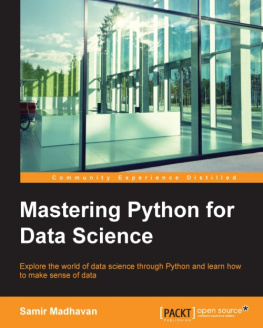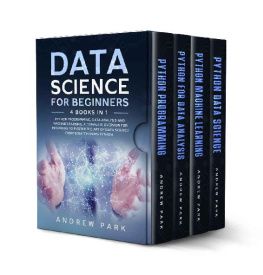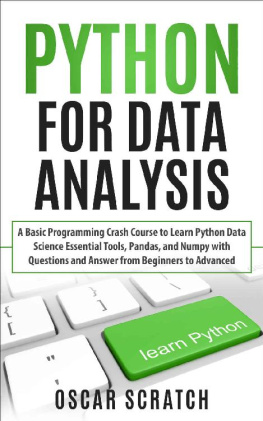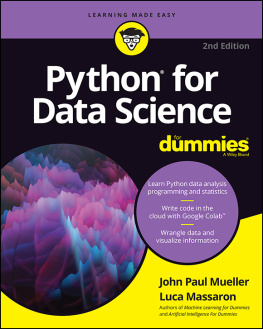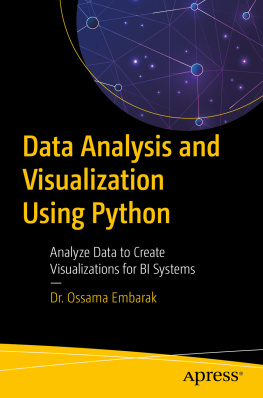PYTHON PROGRAMMING
Python Programming, Data Analysis, Machine Learning. A Complete Overview to Master The Art of Data Science From Scratch Using Python for Business
[Mark Whistler]
Text Copyright [Mark Whistler]
All rights reserved. No part of this guide may be reproduced in any form without permission in writing from the publisher except in the case of brief quotations embodied in critical articles or reviews.
Legal & Disclaimer
The information contained in this book and its contents is not designed to replace or take the place of any form of medical or professional advice; and is not meant to replace the need for independent medical, financial, legal or other professional advice or services, as may be required. The content and information in this book has been provided for educational and entertainment purposes only.
The content and information contained in this book has been compiled from sources deemed reliable, and it is accurate to the best of the Author's knowledge, information and belief. However, the Author cannot guarantee its accuracy and validity and cannot be held liable for any errors and/or omissions. Further, changes are periodically made to this book as and when needed. Where appropriate and/or necessary, you must consult a professional (including but not limited to your doctor, attorney, financial advisor or such other professional advisor) before using any of the suggested remedies, techniques, or information in this book.
Upon using the contents and information contained in this book, you agree to hold harmless the Author from and against any damages, costs, and expenses, including any legal fees potentially resulting from the application of any of the information provided by this book. This disclaimer applies to any loss, damages or injury caused by the use and application, whether directly or indirectly, of any advice or information presented, whether for breach of contract, tort, negligence, personal injury, criminal intent, or under any other cause of action.
You agree to accept all risks of using the information presented inside this book.
You agree that by continuing to read this book, where appropriate and/or necessary, you shall consult a professional (including but not limited to your doctor, attorney, or financial advisor or such other advisor as needed) before using any of the suggested remedies, techniques, or information in this book.
Table of Contents
Introduction
Python is one of the most popular programming languages in the world right now, and its getting more popular all the time. It is powerful, robust, easy to use, and combines a diverse toolkit with intuitive syntax. Given these attributes, its no wonder that Python has become so widely used. However, learning Python isnt necessarily simple. Just like learning any language, theres a lot to learn when it comes to Python, and it can be hard to know exactly where to start. Beyond that, after youve learned Pythons syntax, how do you start completing your own projects? And how do you move from a beginner to an intermediate Python programmer? It can be intimidating just to be handed a set of tools and be expected to use them without any guidance. Dont worry, we will show you how to use the tools you learn about through structured exercises and two projects at the very end.
This book will take you through Python in a step-by-step manner, teaching you the basics and building on those basics to move towards more advanced topics. We begin by covering the basics of Python syntax, such as variables, operators, data types, and data structures. After this, we move on to intermediate topics like functions, modules, and object-oriented programming. After covering these topics, the book will go into some advanced Python techniques, including recursion, image manipulation, and unit testing. Well also spend some time looking at how to use some of the many open-source Python libraries that are available. Finally, the last portion of the book covers two different Python programming projects you can work on to see how all the concepts youve learned come together.
The first project is a story idea generator that will help you understand how to manipulate text and reinforce basic programming principles you learned. The second project is a more challenging weather application that will help you learn how to work with outside data (in this case, data from the Internet), manipulate it, and present it in a user-friendly format. Its essential to know how to collect data from the outside world and integrate it into your programs. This is often the most exciting part of programming.
Python is an excellent language to learn for both first-time programmers and expert programmers who are looking to expand their existing skillset. Pythons intuitive syntax makes it easy to use and learn, so its a good language for first-time programmers to pick up. Despite this, Python is also flexible and extremely powerful, making it well-suited for advanced programmers as well. In fact, Python is used for everything, from mobile app development to DevOps to machine learning and artificial intelligence. Learning Python will dramatically increase the types of jobs youll be able to apply to and be successful in. This is part of the reason Im so passionate about helping others learn Python. It gives you access to all kinds of new techniques and tools that can improve your life in a variety of ways.
If youd like, Python can also help you automate many repetitive tasks you face in your life, saving you a great deal of time and energy. Do you need to fill in a spreadsheet with data from multiple work emails? Python can automate that process, making it quick and easy. Would you like to create your own website where you can host your content? Python can help you do that as well, letting you make highly customizable yet elegant webpages. Do you want to analyze data and learn about the world around you? Python happens to be one of the most widely used languages for data science. If youd like, you can also learn how to implement machine learning with Python, which will open doors to AI.
For all the reasons covered above and more, Python is a fantastic language to learn, and this book will help you go from zero knowledge of Python to a skilled Python programmer. It will provide you with the knowledge you need to start creating your own Python projects and applications successfully. Its worth noting that this book alone wont make you a Python master; youll also need to spend time exploring and developing Python code by yourself. Not only will you need discipline, but youll also need to know where to find additional Python resources. However, this book will give you the fundamentals necessary to start working with more advanced Python concepts. Youll be set on the path to becoming a true and effective Python developer, and youll be able to start exploring on your own, map in hand.
If youre ready to get started, turn the page and dive in.
Chapter 1: Understand Python
The introduction of technologies, especially computers, has influenced our behavior differently. Some people spend most of their time on computers that create programs and websites to make a living, while others mess around with computers to try to understand many different things about how machines work. Programming is one of the areas in networks that most people in the world focus on as a source of income. They can work in a company or computer repair to protect computers from attacks such as hackers or viruses.
However, nothing is easy when it comes to computer technology. Before working on a computer program, it is essential that you focus more on the basic things, including the correct codes and language, as this will allow you to deliver the correct program. With the availability of many cording creation options such as C ++, Python and Java, you can choose a method that you are expert in and that will also facilitate your work. In this book, we will focus on Python and why it is good than other programming languages.




